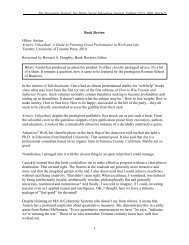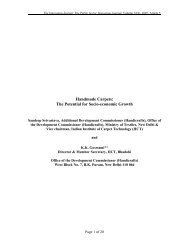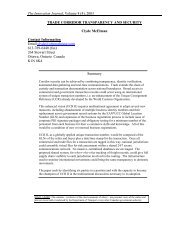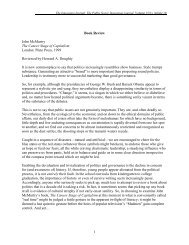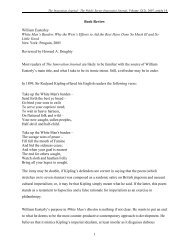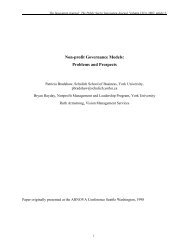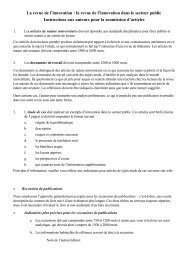The Followership Continuum - The Innovation Journal
The Followership Continuum - The Innovation Journal
The Followership Continuum - The Innovation Journal
Create successful ePaper yourself
Turn your PDF publications into a flip-book with our unique Google optimized e-Paper software.
(Bergmann, et.al., 1999). <strong>The</strong> authors and researchers are exploring the informal leadership<br />
requirements and roles played by followers and reaffirm the situational nature of followership<br />
and leadership.<br />
A third perspective, from which followership is presented, evolves through the writings of Ira<br />
Chaleff (Chaleff, 1998), Geoffrey M. Bellman (Bellman, 1992), and others. <strong>The</strong>y focus attention<br />
on the different characteristics of followership, such as being courageous, being a risk taker, and<br />
being willing to face the leader with the truth.<br />
A fourth construct for examining followership is from the relationship of the servant-leader. This<br />
concept is the focus of research and the teachings of Robert K. Greenleaf and the Robert K.<br />
Greenleaf Center. <strong>The</strong> followership thesis promoted from Greenleaf’s work explains that servant<br />
leaders provide the impetus for followers. <strong>The</strong> servant leader seeks to involve others in decisionmaking.<br />
This concept looks at followership from the related issues of power and authority. <strong>The</strong><br />
contention is that those who choose to follow will not casually accept the authority of<br />
institutions. Instead, followers freely respond to chosen leaders because they have power as<br />
trusted servants (Greenleaf, 1991).<br />
Taken together, there are just a few researchers who focus on the topic of followership, when<br />
compared to more thoroughly studied topics like leadership or even team building. Yet, although<br />
these few efforts address followership differently, they all present legitimate dimensions of<br />
followership, from different constructs. <strong>The</strong>se differences provide greater insights about<br />
followers in the workplace environment and elsewhere in organized group efforts. Together, they<br />
promote greater understanding of the follower and the follower/leader relationship and provide<br />
the foundation for a different dimension of followership.<br />
A new concept about followership is needed; one that adds to the recognition of and the<br />
importance of followership and the contributing roles played by followers in the workplace. A<br />
concept is needed that highlights followership as a range of different performance levels, just as<br />
leadership exists with many different styles and types. <strong>The</strong> exemplary follower encompasses the<br />
situational nature of followership. It also encompasses the development needed to sustain this<br />
best followership level. Moreover, the <strong>Followership</strong> <strong>Continuum</strong> promotes organizational<br />
development that focuses on the importance of followers and the development and promotion of<br />
exemplary followership in organized efforts.<br />
<strong>The</strong> <strong>Followership</strong> <strong>Continuum</strong><br />
<strong>The</strong> <strong>Followership</strong> <strong>Continuum</strong> is an organizational development model that focuses on sustaining<br />
the productivity of the workforce. It provides a gauge for measuring and developing employee<br />
performance output, at the macro level. Consequently, when this workforce output measure is<br />
compared with other outcome measures, comprehensive decisions can be made about changes<br />
that are needed to determine a desired corrective course of action.<br />
<strong>The</strong> <strong>Followership</strong> <strong>Continuum</strong> is based on the concept that an individual’s performance, and thus<br />
the performance of the workforce, is not constant but is ever changing, caused by many<br />
variables. <strong>The</strong>refore, superior performance by an individual under one leader or in a particular<br />
project can change. Also, the consistently non-performing or poor-performing individual can<br />
5




